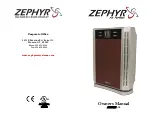
5567611-BIM-B-1218
68
Johnson Controls Ducted Systems
Calculating the cubic feet of gas consumed per hour
1.
To find the BTU input, multiply the number of cubic feet of
gas consumed per hour by the BTU content of the gas in
your particular locality.
Note:
The BTU content of gas varies widely from area to
area, contact your gas company for this information.
By actual measurement, it takes 46 seconds for the hand
on a 1 cubic foot dial to make a revolution with a 80,000
BTU/h furnace running.
2.
To determine rotations per minute, divide 60 by 46 = 1.30.
3.
To calculate rotations per hour, multiply 1.30
60 = 78.
4.
Multiply 78
1 (0.5 if using a 1/2 cubic foot dial) = 78.
5.
Multiply 78
(the BTU rating of the gas). For this example,
assume the gas has a BTU rating of 1050 BTU/ft.
3
.
The result of 81,900 BTU/h is within 5% of the 80,000 BTU/h
rating of the furnace.
Adjusting the manifold gas pressure
This gas furnace has two heat stages. The gas valve has two
adjustment screws located under a plastic protective cover. The
second stage (100% input) adjustment screw is adjacent to the
HI marking on the valve. The first stage (60% input) adjustment
screw is located adjacent to the LO marking on the valve (see
Figure 32).
Adjust the second stage (100% input) pressure first, then adjust
first stage (60% input) pressure.
1.
Turn off electrical power to the unit.
2.
Using the outlet pressure port on the gas valve, connect a
manometer to monitor the manifold pressure.
3.
Remove the plastic cap that covers the HI and LO pressure
adjustment screws.
4.
Turn on electrical power to the unit.
5.
Set the thermostat to call for second stage heat and start
the furnace.
6.
If necessary, use a screwdriver to turn the
second stage
adjustment screw clockwise to increase manifold pressure
or counterclockwise to decrease manifold pressure.
Note:
Do not to over-fire the unit on second stage.
7.
After you check the high manifold pressure, adjust the
thermostat to call for first stage heat.
8.
If necessary, use a screwdriver to turn the first stage
adjustment screw clockwise to increase manifold pressure
or counterclockwise to decrease manifold pressure.
Note:
Do not to under-fire the unit on first stage.
9.
After you check the pressure, replace the plastic cap
covering the HI and LO pressure adjustment screws.
Note:
When using natural gas, the manifold pressure for
second stage (100% input) is 3.5 IWG ± 0.3. The
manifold pressure for first stage (60% input) when
using natural gas is 1.5 IWG ± 0.3.
Adjusting the temperature rise
The temperature rise is the difference of temperature between
the return air and the heated air from the furnace. The
temperature rise must lie within the range shown on the CSA
rating plate and the data in Table 13.
1.
After about 20 minutes of operation, determine the furnace
temperature rise. Take readings of both the return air and
the heated air in the ducts (about 6 feet from the furnace)
where they are not affected by radiant heat.
Table 29: Gas rate cubic feet per hour
Seconds for
One Rev.
Size of Test Dial
1/2 cu. ft.
1 cu. ft.
10
180
360
12
150
300
14
129
257
16
113
225
18
100
200
20
90
180
22
82
164
24
75
150
26
69
138
28
64
129
30
60
120
32
56
113
34
53
106
36
50
100
38
47
95
40
45
90
42
43
86
44
41
82
46
39
78
48
37
75
50
36
72
52
35
69
54
34
67
56
32
64
58
31
62
60
30
60
Table 30: Gas heat stages
Unit
No. of burner
tubes
1st stage input
(100% BTU/h)
2nd stage input
(60% BTU/h)
-06, -07, -08, -
10, -12
4
120,000
72,000
6
180,000
108,000
8
240,000
144,000
Table 31: Gas heat limit control settings
1
1. Roll-out = 300°F, Auxiliary limit = 200°F
Unit
Main limit setting °F
Size
Option
-06
N12
165
N18
165
-07
N12
165
N18
165
-08
N12
215
N18
195
-10
N18
195
N24
160
-12
N18
195
N24
160
















































